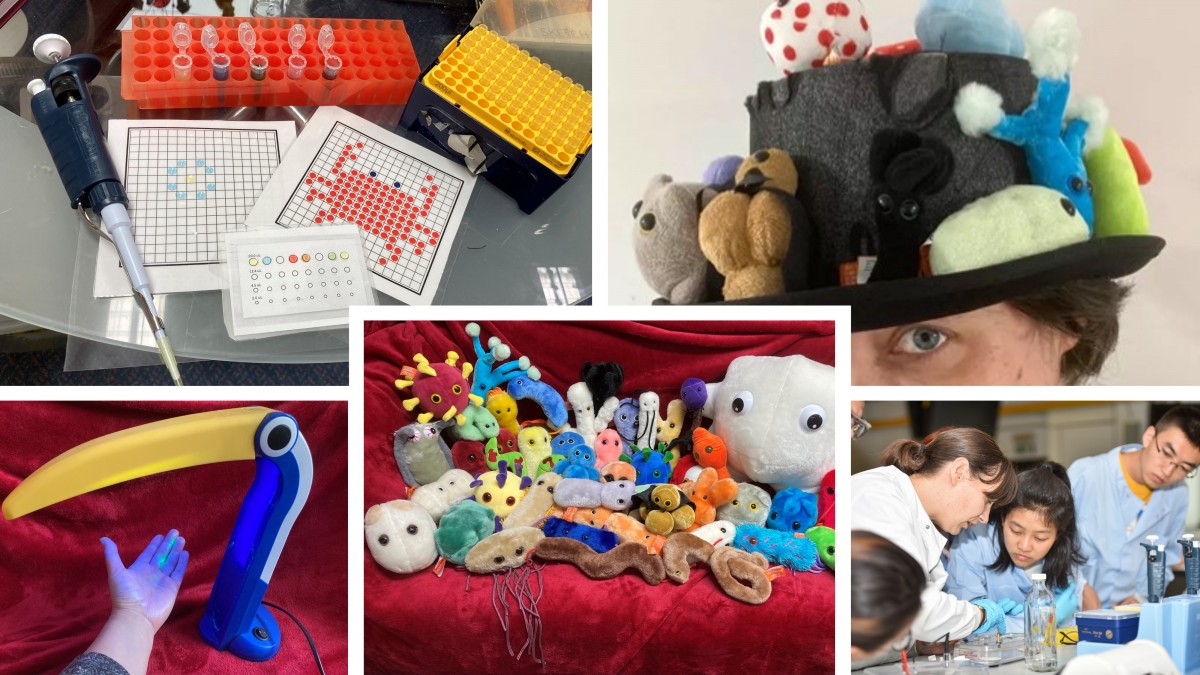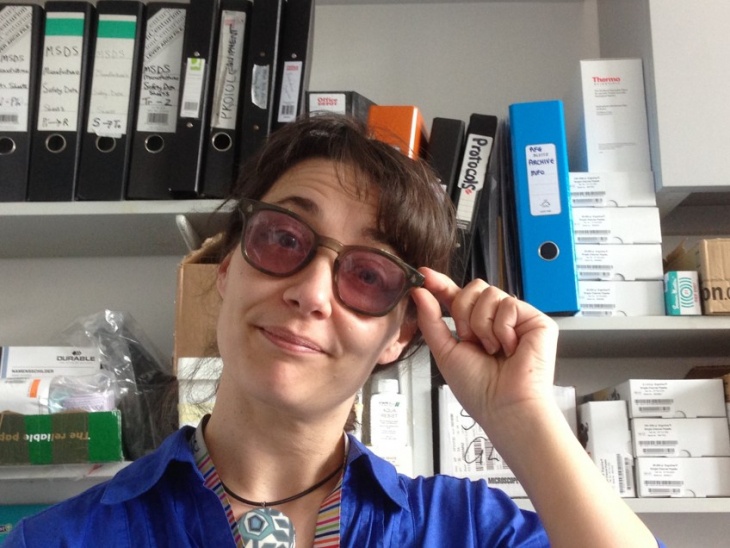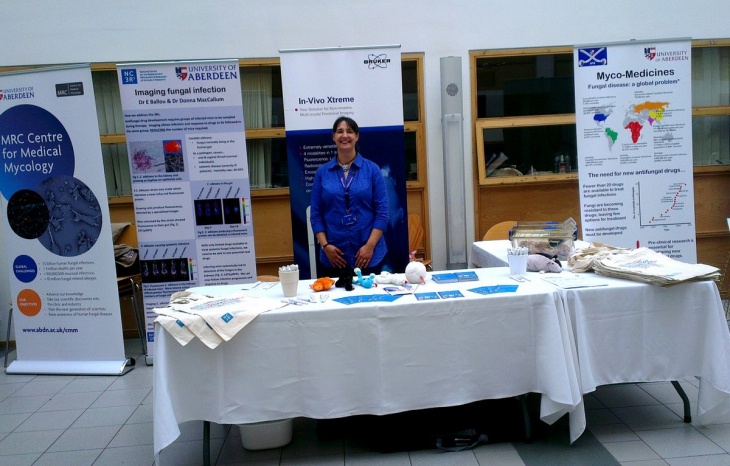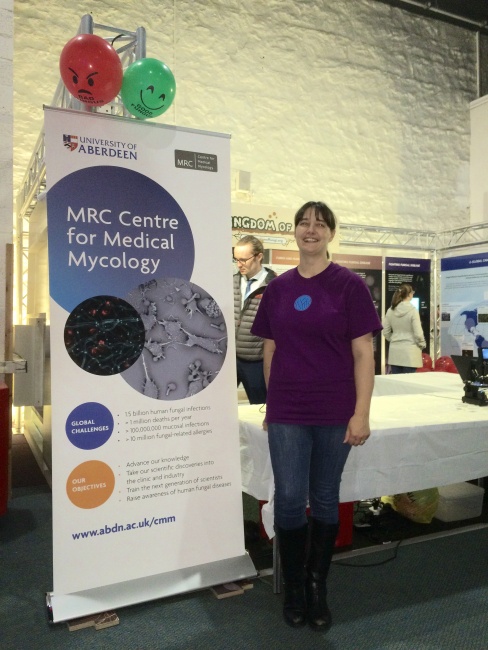
BSc (Hons) Genetics; PhD (Microbiology); PGCE (Higher Education Teaching); FHEA; FRSB
Reader and BSc Programme Lead
- About
-
- Email Address
- d.m.maccallum@abdn.ac.uk
- Telephone Number
- +44 (0)1224 437425
- Telephone Number
- +44 (0)1224 437462
- Office Address
Aberdeen Fungal Group
Institute of Medical Sciences (Office 4.21)
University of Aberdeen
Foresterhill
Aberdeen
AB25 2ZD- School/Department
- School of Medicine, Medical Sciences and Nutrition
Biography
Current PhD students

PhD students Helen Heaney, Dora Corzo Leon, Ambre Chapuis, Stylianos Simantirakis, Dan Larcombe
Reviewing

Public Engagement - STEM Ambassador
Donna MacCallum has been a registered STEM ambassador since 2012 and has carried out public engagement activities in nurseries, primary schools, secondary schools, science festivals and more...
Qualifications
- BSc Genetics (Honours)1994 - University of AberdeenFirst Class
- PhD Microbiology1999 - University of AberdeenmRNA differential display to investigate yeast-hypha dimorphism in Candida albicans
- PGCert Higher Education Teaching and Learning2004 - University of Aberdeen
- FHEA Education2007 - Higher Education Academy
- FRSB Biology2013 - Royal Society of Biology
Memberships and Affiliations
Latest Publications
Malassezia sympodialis Mala s 1 allergen is a potential KELCH protein that cross reacts with human skin
FEMS Yeast Research, vol. 23, foad028Contributions to Journals: ArticlesAn inclusive strategy to enhance equity and quality of research-led teaching experience
Contributions to Conferences: Oral PresentationsA Human Ex Vivo Skin Model to Study Candida auris Biofilms
Methods in molecular biology (Clifton, N.J.), vol. 2517, pp. 259-267Contributions to Journals: Articles- [ONLINE] DOI: https://doi.org/10.1007/978-1-0716-2417-3_21
Mouse Gastrointestinal Colonization Model for Candida auris
Methods in molecular biology (Clifton, N.J.), vol. 2517, pp. 329-340Contributions to Journals: Articles- [ONLINE] DOI: https://doi.org/10.1007/978-1-0716-2417-3_26
Blocking Polyphosphate Mobilization Inhibits Pho4 Activation and Virulence in the Pathogen Candida albicans
mBio, vol. 13, no. 3, e00342-22Contributions to Journals: Articles
Prizes and Awards
Honorary membership of the British Society for Medical Mycology (year)
Principal's Prize for Public Engagement (Public Prize) (year)
- Research
-
Research Overview
My research has centred on investigating fungal pathogenesis and virulence, focussing mainly on the opportunistic fungal pathogen Candida albicans and mouse models of infection. It also addresses the 3Rs: Replacement, Reduction and Refinement of animals in research, refining infection models and developing new ways to follow infection in animals.
Initially, my research focussed on investigating pathogenesis from the fungal perspective, using experimental infection models to assay the contribution of fungal gene products in virulence. I have also used microarray analyses to compare gene expression in known virulent and attenuated C. albicans clinical isolates, demonstrating that there are few differences under laboratory conditions (Eukaryotic Cell, 2009).
More recently, my research has extended into examining host responses, particularly immune responses, during infection in mice. By examining host responses to different C. albicans clinical isolates, I have demonstrated that low virulence isolates stimulate a lower innate immune response than more virulent isolates and that it is the early host response that determines infection outcome (PLoS One, 2009). A study to determine the early renal transcriptional response during progressive C. albicans infection confirmed the massive induction of innate immune responses (FEMS Yeast Research, 2009).
My major goal is to gain a better understanding of the factors leading to susceptibility to opportunistic fungal infections and to identify crucial events occurring during infection development, which could potentially allow identification of novel clinical management or therapeutic strategies for these infections.
Research Areas
Accepting PhDs
I am currently accepting PhDs in Biomedical Sciences.
Please get in touch if you would like to discuss your research ideas further.
Research Specialisms
- Medical Sciences
- Microbiology
- Animal Science
- Mycology
Our research specialisms are based on the Higher Education Classification of Subjects (HECoS) which is HESA open data, published under the Creative Commons Attribution 4.0 International licence.
Knowledge Exchange
Dr Donna MacCallum is very active in public engagement.
She has contributed school workshops, public lectures and family activities at the University of Aberdeen May Festival for each of the four years that the festival has run (https://www.abdn.ac.uk/mayfestival/).
She is a registered STEM ambassador (http://www.stemnet.org.uk/ambassadors/) and has carried out science workshops in schools. Most recently, she was successful in obtaining a Royal Society Partnership grant with Ms Amanda Kirk of Gilcomstoun Primary School, Aberdeen to carry out a resarch project to investigate whether household cleaners are effective again fungi (2016) (https://royalsociety.org/grants-schemes-awards/grants/partnership-grants/). She was also able to contribute towards Gilcomstoun Primary School's science activities, which contributed to their successful Primary Science Quality Mark Gold Award application (2016).
Dr MacCallum was also awarded one of the first National Centre for Replacement, Refinement and Reduction of Animals in Research (NC3Rs) public engagement awards (2016) to talk about how the University of Aberdeen are addressing the 3Rs in their life science research at Doors Open Day 2016 in the Institute of Medical Sciences, University of Aberdeen.
Dr MacCallum was also successful in being awarded the first Microbiology Society Microbiology in Society Awards (2016) in collaboration with University of Aberdeen Public Engagement Unit (PERU) and Aberdeen Science Centre to produce a new exhibit to explore the human gut microbiota.
Dr MacCallum has also been awarded a Microbiology Society Public Engagement Award (2010) to carry out "germ busting" with nursery children, where the children were shown effective handwashing and their technique was evaluated using UV lamps and fluorescent hand cream.
Dr MacCallum recently also designed and ran a Kids Zone workshop for the Killer Fungus exhibit at the Royal Society Summer Science Exhibition in London (2016) (https://royalsociety.org/science-events-and-lectures/summer-science-exhibition/).
She will be taking part in Explorathon 2016 at the Aberdeen Science Centre, explaining the resarch carried out in the Aberdeen Fungal Group at the Kingdom of Fungi exhibit (http://www.explorathon.co.uk/aberdeen/asc).


Supervision
My current supervision areas are: Biomedical Sciences.
Current Staff
- Ms. Hazel Bell (Technician)
Current PhD Students

PhD students: Helen Heaney, Dora Corzo Leon, Ambre Chapuis, Stelmos Simantirakis, Dan Larcombe at the Human Fungal Pathogen course in Nice, France.
- Mr Stylianos Simantirakis
- Ms Helen Heaney (Co-supervised by Dr Alan Walker and University of Exeter's Professor Al Brown)
- Mr Dan Larcombe (Co-supervised by University of Exeter's Professor Al Brown)
Completed PhD Students
- Dr Simon Vautier (co-supervised with Professor Gordon Brown) (2013)
- Dr Edina Szabo (primary supervisor) (2014)
- Dr Shane Smith (co-supervised with Dr Carol Munro) (2014)
- Dr Beatrice Achen (Main Supervisor: Professor Janet Quinn, Newcastle University) ()
- Dr Chibuike Ibe (Main supervisor: Professor Carol Munro) (2019)
- Dr Prashant Sood (Main supervisor: Professor Al Brown)
- Dr Ambre Chapuis (co-supervisor Dr Liz Ballou) (2020)
- Dr Dora Corzo Leon (co-supervisor Dr Carol Munro) (2020)
- Teaching
-
Programmes
- Postgraduate, 3 stage, September start
Programme Coordinator
- Postgraduate, 3 stage, January start
Programme Coordinator
Courses
Course Coordinator
Course Coordinator
Teaching Responsibilities
Postgraduate Teaching Academic Lead for the School of Medicine, Medical Sciences & Nutrition
Co-ordinator Roles
- MSc Microbiology Programme Coordinator (September and January start)
Undergraduate Teaching (lecturing)
- MC3504 Molecular Microbiology
- IM3502 Applied Immunology - Human Health
- Honours Immunology
- Honours Microbiology
- Honours Project Supervisor
Research Project Supervision
- BSc Honours project supervisor
- MSc/MRes Research Project supervisor
Non-course Teaching Responsibilities
Personal Tutor
Pastoral support for MSc students
University of Aberdeen Postgraduate Taught committee
University of Aberdeen Directors of Teaching and Learning Group
- Publications
-
Page 2 of 5 Results 26 to 50 of 101
Host-Imposed Copper Poisoning Impacts Fungal Micronutrient Acquisition during Systemic Candida albicans Infections
PloS ONE, vol. 11, no. 6, e0158683Contributions to Journals: ArticlesThe Rewiring of Ubiquitination Targets in a Pathogenic Yeast Promotes Metabolic Flexibility, Host Colonization and Virulence
PLoS Pathogens, vol. 12, no. 4, 1005566Contributions to Journals: ArticlesContribution of Fdh3 and Glr1 to Glutathione Redox State, Stress Adaptation and Virulence in Candida albicans
PloS ONE, vol. 10, no. 6, e0126940Contributions to Journals: Articles- [ONLINE] DOI: https://doi.org/10.1371/journal.pone.0126940
- [OPEN ACCESS] http://aura.abdn.ac.uk/bitstream/2164/4604/1/PlosOne_0126940.pdf
Candida albicans colonization and dissemination from the murine gastrointestinal tract: the influence of morphology and Th17 immunity
Cellular Microbiology, vol. 17, no. 4, pp. 445-450Contributions to Journals: ArticlesFungal Chitin Dampens Inflammation through IL-10 Induction Mediated by NOD2 and TLR9 Activation
PLoS Pathogens, vol. 10, no. 4, e1004050Contributions to Journals: Articles- [ONLINE] DOI: https://doi.org/10.1371/journal.ppat.1004050
- [OPEN ACCESS] http://aura.abdn.ac.uk/bitstream/2164/3463/1/Fungal_chitin.pdf
Expansion of Foxp3+ T-cell populations by Candida albicans enhances both Th17-cell responses and fungal dissemination after intravenous challenge
European Journal of Immunology, vol. 44, no. 4, pp. 1069-1083Contributions to Journals: Articles- [ONLINE] DOI: https://doi.org/10.1002/eji.201343604
- [OPEN ACCESS] http://aura.abdn.ac.uk/bitstream/2164/3241/1/EJI_whibley.pdf
A novel renal epithelial cell in vitro assay to assess Candida albicans virulence
Virulence, vol. 5, no. 2, pp. 1-11Contributions to Journals: Articles- [ONLINE] DOI: https://doi.org/10.4161/viru.27046
Murine model for Fusarium oxysporum invasive fusariosis reveals organ-specific structures for dissemination and long-term persistence
PloS ONE, vol. 9, no. 2, e89920Contributions to Journals: Articles- [ONLINE] DOI: https://doi.org/10.1371/journal.pone.0089920
- [OPEN ACCESS] http://aura.abdn.ac.uk/bitstream/2164/3234/1/fusarium_model.pdf
Ybp1 and Gpx3 signaling in Candida albicans govern hydrogen peroxide-induced oxidation of the Cap1 transcription factor and macrophage escape
Antioxidants & Redox Signaling, vol. 19, no. 18, pp. 2244-2260Contributions to Journals: ArticlesFungal iron availability during deep seated candidiasis is defined by a complex interplay involving systemic and local events
PLoS Pathogens, vol. 9, no. 10, e1003676Contributions to Journals: ArticlesEnhanced efficacy of synergistic antifungal combination treatments versus Candida albicans in insect and murine models of systemic infection
European Journal of Clinical Microbiology & Infectious Diseases, vol. 32, no. 8, pp. 1055-1062Contributions to Journals: Articles- [ONLINE] DOI: https://doi.org/10.1007/s10096-013-1850-8
Role of the Candida albicans MNN1 gene family in cell wall structure and virulence
BMC Research Notes, vol. 6, pp. 1-9Contributions to Journals: Articles- [ONLINE] DOI: https://doi.org/10.1186/1756-0500-6-294
- [OPEN ACCESS] http://aura.abdn.ac.uk/bitstream/2164/8835/1/art_3A10.1186_2F1756_0500_6_294.pdf
- [ONLINE] View publication in Scopus
The Mnn2 mannosyltransferase family modulates mannoprotein fibril length, immune recognition and virulence of Candida albicans
PLoS Pathogens, vol. 9, no. 4, e1003276Contributions to Journals: ArticlesDifferential adaptation of Candida albicans in vivo modulates immune recognition by dectin-1
PLoS Pathogens, vol. 9, no. 4, e1003315Contributions to Journals: ArticlesMouse Model of Invasive Fungal Infection
Mouse Models of Innate Immunity: Methods and Protocols. Allen, I. C. (ed.). Humana Press, pp. 145-153, 9 pagesChapters in Books, Reports and Conference Proceedings: Chapters- [ONLINE] DOI: https://doi.org/10.1007/978-1-62703-481-4_17
- [ONLINE] View publication in Scopus
Dectin-1 is not required for controlling Candida albicans colonisation of the gastrointestinal tract
Infection and Immunity, vol. 80, no. 12, pp. 4216-4222Contributions to Journals: Articles- [ONLINE] DOI: https://doi.org/10.1128/IAI.00559-12
Candida albicans evades protective immunity by promoting the expansion of induced CD4(+) CD25(+) FoxP3(+) Helioslo regulatory T cells that enhance Th17 responses
European Congress of Immunology, pp. 206-206Contributions to Journals: Abstracts- [ONLINE] DOI: https://doi.org/10.1111/imm.12002
Echinocandin resistance due to simultaneous FKS mutation and increased cell wall chitin in a Candida albicans bloodstream isolate following brief exposure to caspofungin
Journal of Medical Microbiology, vol. 61, no. 9, pp. 1330-1334Contributions to Journals: Articles- [ONLINE] DOI: https://doi.org/10.1099/jmm.0.045047-0
Host carbon sources modulate cell wall architecture, drug resistance and virulence in a fungal pathogen
Cellular Microbiology, vol. 14, no. 9, pp. 1319-1335Contributions to Journals: ArticlesA new in vitro model of host-fungus interaction
Mycoses, vol. 55, no. s4, pp. 299-299Contributions to Journals: Abstracts- [ONLINE] DOI: https://doi.org/10.1111/j.1439-0507.2012.02206.x
- [ONLINE] View publication in Scopus
Host carbon sources modulate cell wall architecture and virulence in Candida albicans
Mycoses, vol. 55, no. s4, pp. 172-173Contributions to Journals: Articles- [ONLINE] DOI: https://doi.org/10.1111/j.1439-0507.2012.02206.x
State of the art: Mouse models of invasive candidiasis
Mycoses, vol. 55, no. s4, pp. 10-11Contributions to Journals: Abstracts- [ONLINE] DOI: https://doi.org/10.1111/j.1439-0507.2012.02204.x
Ypd1-mediated two-component signalling in Candida albicans
Mycoses, vol. 55, no. s4, pp. 15-15Contributions to Journals: Abstracts- [ONLINE] DOI: https://doi.org/10.1111/j.1439-0507.2012.02204.x
Molecular and proteomic analyses highlight the importance of ubiquitination for the stress resistance, metabolic adaptation, morphogenetic regulation and virulence of Candida albicans
Molecular Microbiology, vol. 84, no. 3, pp. 594Contributions to Journals: Articles- [ONLINE] DOI: https://doi.org/10.1111/j.1365-2958.2012.08035.x
C-type lectin receptors and cytokines in fungal immunity
Cytokine, vol. 58, no. 1, pp. 89-99Contributions to Journals: Articles



